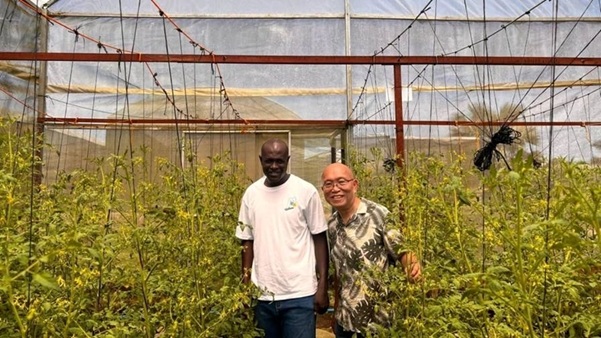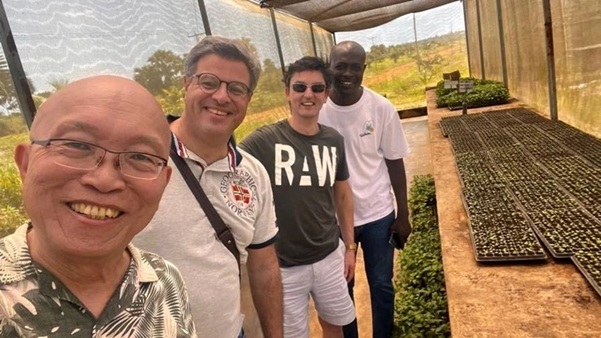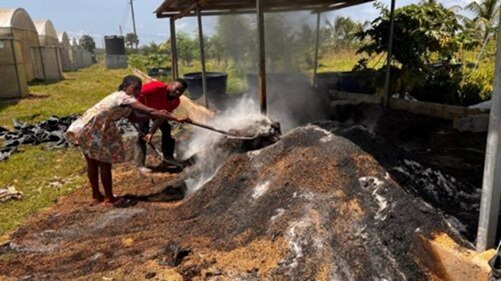
Felix Kamassah (left) and CS Liew in one of the many greenhouses at Kamassah’s farm in Ghana. Photo: CS Liew
Africa's Agricultural Potential: A Growing Opportunity
For decades, Africa has been portrayed as poor and underdeveloped, with widespread malnutrition. Charitable organizations often show heartbreaking images of starving children in fundraising campaigns. While this reflects reality in the arid Sahara zone — the northern one-third of the continent — it does not represent the vibrant and fertile regions of sub-Saharan Africa (the lower two-thirds), where conditions are far more favorable.
Driving this Growing Trend
Filling the northern hemisphere’s off-season needs: For years, Europe has imported fresh produce and ornamentals from Africa during the winter months to fill supermarket shelves. The proximity and frequent shipping between Africa and Europe make freight efficient and cost-effective. Recently, several additional factors have strengthened Africa’s case as a future food basket for Europe.
Climate change mitigation initiatives of the EU: The European Union’s efforts to achieve net-zero carbon emissions by 2050 have reshaped agricultural policy. In the Netherlands, for example, the government has begun culling dairy cattle to reduce nitrogen and ammonia emissions. As agriculture contributes 16% of the country’s emissions, this move will likely raise food prices, creating opportunities for African farmers to step in and meet demand.
Farm to Fork Strategy: In addition to climate efforts, the EU is pushing sustainable and regenerative agriculture under the Farm to Fork Strategy, part of the European Green Deal. This policy aims to reduce the use of chemical fertilizers by 20% and pesticides by 50% by 2030. Although the war in Ukraine temporarily disrupted this effort due to spiking food and fertilizer costs, implementation has resumed with easing prices. This boosts Africa's potential as a key supplier.
Energy costs limiting European production: The war in Ukraine and resulting sanctions on Russian energy have driven up energy prices in Europe. This has made indoor farming and greenhouse cultivation economically unviable during winter. As a result, Africa becomes the preferred source for year-round fresh produce.
Looking Ahead: Can Africa Become the EU’s Sustainable Food Basket?
With these shifts, the question is no longer if, but how African countries can rise to meet demand. The first and most crucial requirement is compliance with EU agricultural standards and regulations. Fortunately, certification bodies and auditing services are already available in countries like South Africa and Kenya.

Interested Dutch financiers and investors along with CS Liew (front) touring Kamassah’s farm. Photo: CS Liew
Preparing Africa for EU Export Standards
Investors and farmers need to be mindful of the proposed “Mirroring Clause” being considered in the European Union, which would prohibit the use of chemical pesticides banned in the EU on crops grown for export to EU countries.
Although Africa’s population is growing, working on farms is not a popular choice — especially in intense summer heat that can exceed 40°C (104°F). Labor must be incentivized with fair pay, around $50 per day. This highlights the need for investment in irrigation, mechanization, automation, and post-harvest infrastructure.
Key Areas for Improvement
Improvements in seed genetics and crop varieties are critical. Traditional or local varieties may not be suitable for export. For example, Ghana’s native mango, while sweet and flavorful, contains too much fiber for certain markets.
Greater use of biosolutions is essential to meet EU standards, as there is nearly zero tolerance for chemical residues on imported crops.
Government Support and Partnerships
To help African countries benefit from exporting to the EU, governments should support farmers by allowing duty-free imports of farm machinery and inputs. Providing financing for working capital, farm modernization, and post-harvest facilities will also enhance competitiveness.
Public-private partnerships can boost food production that meets EU export standards. The private sector — including investors from Africa, Europe, the Middle East, and China — must take the lead. In turn, public institutions should welcome them with incentives and an open-door policy.
A Ghanaian Example: Dr. Felix Kamassah
One success story is a 2,500-hectare vegetable farm started by Dr. Felix Kamassah, located two hours from Accra, Ghana’s capital. Over 10 years, Kamassah expanded the farm by another 3,000 hectares in a separate location. The government is now offering him even more land — a clear signal of success and trust.
Dr. Kamassah grew up in rural Ghana and has a background in economics, holding a doctorate from the Swiss School of Business and Management. He is also President of the Vegetable Producers and Exporters Association of Ghana.
Of the 27 crop varieties cultivated on his farm, seven are currently exported to four major European buyers, including a large UK supermarket chain. These export crops include yam, sweet potato, chili, cherry tomatoes, okra, and shallots.

Workers at Kamassah’s farm in Ghana prepare growing medium, which is a mixture of burnt rice husks. Photo credit: CS Liew
Innovative Growing Techniques
Crops at Kamassah’s farm are mostly grown in polybags under covered sheds. The growing medium used is a mixture of burnt rice husks, which helps minimize pests and diseases. This method improves crop health and reduces the need for chemical inputs.
Vision for Local Processing
With an entrepreneurial and hands-on mindset, Kamassah is planning to produce sweet potato flour for use in snacks, pizza, and bread. This would reduce reliance on imported wheat flour — an import that costs Ghana around $40 million annually and has become more expensive due to the war in Ukraine.
Challenges and Focus Areas
Despite success, Kamassah faces key challenges such as high labor costs, limited mechanization, and insufficient post-harvest handling. His priorities now include automation, mechanization, and the construction of cold storage facilities to reduce waste and improve efficiency.
Investment Interest
Given the strong profitability of his operations and unmet European demand, the farm has attracted interest from multiple financiers and investors. These are clear signs of the farm’s potential for further expansion.
Conclusions
Current developments within the EU and Africa are aligning to position Africa as a sustainable, long-term food basket for Europe. There are major opportunities for financing, supply of agricultural machinery, crop covers, seed improvements, and advanced crop protection and nutrition solutions.
Due to the EU’s zero-tolerance policy on chemical residues in food imports, the demand for biosolutions is rising fast. This opens up an entirely new market for clean, sustainable farming from Africa.
What a twist of fate — a continent once portrayed through images of malnourished children is now feeding a wealthy, developed Europe. And in doing so, it’s building its own path toward food security.
* The European Commission launched the European Green Deal (EGD) in 2019 to reduce greenhouse gas emissions and promote sustainable economic growth. This means all products sold in the EU — including food imports — must meet strict sustainability criteria.
Source: Agri-Business Global